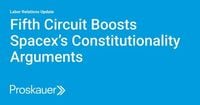On August 19, 2025, a seismic shift rattled the foundations of American labor law. The U.S. Court of Appeals for the Fifth Circuit handed down a decision that could reshape the relationship between workers, unions, and employers for years to come. In a unanimous ruling by a three-judge panel—all appointed by Republican presidents—the court declared the structure of the National Labor Relations Board (NLRB) unconstitutional, siding with SpaceX and two other companies, Energy Transfer and Findhelp, in their challenge against the federal agency.
The ruling, authored by Judge Don Willett, a Donald Trump appointee, suspended ongoing unfair labor practice proceedings against the companies. According to Truthout, the court found that the safeguards protecting NLRB board members and administrative law judges (ALJs) from removal by the president violated the separation of powers outlined in the U.S. Constitution. Judge Willett wrote that it constitutes "irreparable harm" for companies to be subject to cases when an agency's structure runs afoul of constitutional principles, stating, "When an agency’s structure violates the separation of powers, the injury arises from the process itself—rather than its outcome."
This decision comes at a particularly charged moment for American labor. The NLRB is the federal agency tasked with enforcing labor laws, adjudicating disputes between employers and employees, and overseeing union elections. It has played a central role in the recent surge of unionization efforts across the country, handling a wave of unfair labor practice filings that have accompanied renewed activism in workplaces from warehouses to tech companies.
Bloomberg Law reporter Robert Iafolla noted that the Fifth Circuit's decision could provide companies in Texas, Louisiana, and Mississippi—the states under the court's jurisdiction—a new legal avenue to block NLRB cases simply by filing constitutional lawsuits against the agency. The ripple effect? A potential patchwork of labor rights across the country, with workers in some states left with fewer protections than others.
SpaceX, the high-profile rocket company led by billionaire Elon Musk, has been at the center of labor controversies before. The company faced accusations of unfair labor practices, including a complaint last year from the NLRB alleging that SpaceX illegally fired eight employees who signed a letter criticizing what they described as a sexist environment within the company. According to People’s World, SpaceX and the other two companies argued that the NLRB’s structure—particularly the insulation of its board members and ALJs from presidential removal—was unconstitutional, and sought relief from federal courts in Texas. They got it, and now the Fifth Circuit has affirmed those injunctions.
The court’s reasoning leaned heavily on constitutional arguments. It found that NLRB ALJs are “inferior officers” under the law and that the “two layers of for-cause protection” shielding them from removal is, in the court’s view, per se unconstitutional. The court cited the ALJs’ authority to issue sanctions and make final decisions (unless appealed), granting them what it called "substantial authority" over NLRB proceedings. For Board Members, the court argued that their combination of executive, policymaking, and prosecutorial powers, paired with a lack of partisan balance, made their removal protections especially problematic. The majority opinion suggested that the precedent set by Humphrey’s Executor—which upheld similar protections for Federal Trade Commission commissioners—should not extend to the NLRB.
Judge Jacques Wiener, however, dissented in part. He argued that the employers had not shown the kind of irreparable harm required to justify an injunction, warning that the majority’s holding "both departs from Supreme Court precedent and creates a circuit split." He referenced Collins v. Yellen, which, he contended, requires a more direct showing of harm from unconstitutional removal provisions before courts can intervene.
The immediate impact of this ruling is to halt NLRB proceedings against SpaceX, Energy Transfer, and Findhelp while the constitutional challenge plays out. But the broader implications are far more sweeping. As Common Dreams reported, Senator Bernie Sanders was quick to weigh in, blasting the ruling as an example of oligarchy. Sanders stated, "This is what oligarchy looks like: Today, 2 Trump judges ruled that the NLRB’s structure is unconstitutional giving Elon Musk, worth $410 billion, and other union busters the absolute power to exploit workers and violate labor law with impunity." He called the decision “disastrous” and insisted, "This disastrous decision cannot stand."
Labor advocates echoed Sanders’ concerns, warning that the decision could tip the balance of power sharply in favor of employers. With the NLRB’s authority under threat, companies accused of violating workers’ rights might evade accountability simply by challenging the agency’s structure in court. As People’s World observed, if the Fifth Circuit’s decision is upheld, the U.S. could "return to the Wild West days of widespread and sometimes violent corporate repression of workers, reminiscent of the 1930s." Yet, some labor organizers noted that the NLRB process itself has long been a maze of legal hurdles for unions—a system that, while designed to protect workers, has also been shaped by decades of corporate influence and congressional amendments since 1947.
The ruling is expected to be appealed, and many legal experts believe the dispute is destined for the U.S. Supreme Court. The outcome could have profound consequences not only for the tenure and composition of the NLRB but for the future of federal labor law itself. The case also comes as the Trump administration continues its overhaul of union and worker protections, including moves to "gut the NLRB," according to Truthout, and as President Trump has nominated two new Board Members to the agency.
For now, the legal uncertainty leaves both workers and employers in limbo. Will the Supreme Court uphold the Fifth Circuit’s view and upend nearly a century of labor law precedent? Or will it reaffirm the NLRB’s structure and its role as the guardian of workers’ rights? The stakes could hardly be higher, and the outcome will shape the American workplace for generations to come.
As the dust settles, one thing is clear: the battle over the NLRB’s future is far from over, and the eyes of the nation’s workers, unions, and employers are fixed on what comes next.
